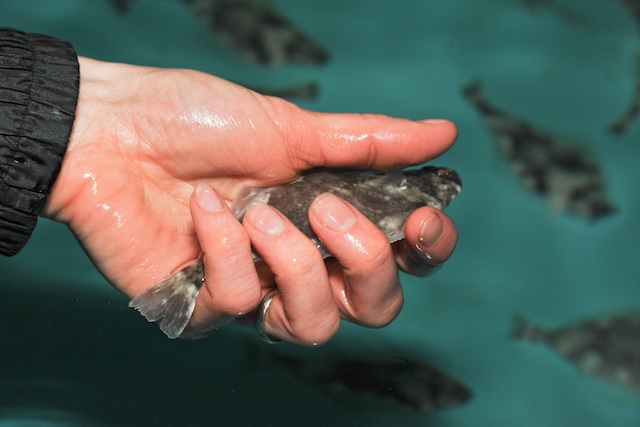
Features
Research
Technology: Lights, Tank, Action
January 29, 2014 By William Stoichevski
 Halibut P.E.I.
Halibut P.E.I.Halibut P.E.I, a Canadian company based in Prince Edward Island, recently completed projects examining the impact of different lighting regimes, feed types and tank design.
“We’ve done different things over the years on lighting,” says Gerald Johnson, aquaculture veterinarian and director of science with Halibut P.E.I. “We tried green lights, red lights, low intensity lights, and high intensity lights. We tried balanced spectrum lights at low intensity and high intensity. We could never get any different results – the fish didn’t seem to care.”
Although halibut are deep water fish and live where there is little light, they seem to have the ability to adjust to any lighting intensity, colour and quality, says Johnson.
Nor did the company’s research on feed types reveal any conclusive findings.
“We tried four different protein levels in commercial feed, thinking that we would get a variation in response,” notes Johnson, “and we did, but not enough variation to give us good results. We had trends. It looked like we could go to a slightly lower protein level but it wasn’t a trend that I would make a firm statement on.”
Much of the fundamental research that has been done with other species hasn’t been done with halibut, notes Peter Warris, research & development coordinator, P.E.I. Aquaculture Alliance.
“There is some halibut research out there but there’s not much of it really and our situation here is the fish are grown in tanks fed by salt water wells, which means the research that exists doesn’t necessarily translate,” says Johnson. “Most of the research comes out of Norway and has been done in full strength sea water with salinity of 32 parts per thousands. Our salinity here is about 23-26 parts per thousand.”
Feed research will probably continue in the future, notes Johnson.
“We will continue to work with the feed companies to see whether we can make minor changes that would be in our best interest but right now until the base research is done at this salinity, I don’t think we will get the results we are looking for and I don’t know how we are going to find that base research at the moment.”
Halibut P.E.I. has also conducted research into tank design and is currently involved in sediment research.
“We’ve played with flow patterns in our tanks,” says Johnson. “University Of Prince Edward Island engineering students looked at our grading equipment and tank design. Modifications were made to the tanks but we didn’t see any difference in fish growth. We are doing a sediment trial here right now. Halibut mucus sticks to everything and it’s a real problem because it gums up filters. We are in the developmental phase of looking at determining how to sediment it out.”
Johnson is enthusiastic about the future of halibut farming on the Island.
“We believe that halibut is a great fish and we also believe that the conditions on Prince Edward Island are suitable for growing halibut,” comments Johnson. “There’s little doubt that this is a great fish for aquaculture because it’s robust and makes a very fine product.”
Angela Altass
Print this page





